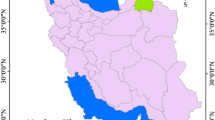Abstract
A fuzzy logic-based methodology modeling the early warning of risk to manage grassland fires in Inner Mongolia is presented. By establishing a membership function, this study first analyzed grassland fire hazard and vulnerability and subsequently integrated hazard and vulnerability using the fuzzy logic method to develop the Grassland Fire Risk Early Warning Index. The key parameters in the model were obtained by methods of undetermined parameters. The reliability of early warning results was demonstrated using historical grassland fires and grassland fire disasters. The results from this study are intended to support local, provincial, and national government agencies in making decisions in resource allocation, high-level planning and raising the public’s risk awareness of grassland fires.




Similar content being viewed by others
References
Bachmann A, Allgöwer B (2001) A consistent wildland fire risk terminology is needed! Fire Manag Today 61:28–33
Finney MA (2005) The challenge of quantitative risk analysis for wildland fire. For Ecol Manag 211:97–108
González JR, Palahí M, Tasobares A, Pukkala T (2006) A fire probability model for forest stands in Catalonia (north-east Spain). Ann For Sci 63:169–176
Gu ZJ, Zheng ZY (2005) Overview of researches on vegetation coverage in remote sensing. Res Soil Water Conserv 12:18–21
Guettouche MS, Derias A, Boutiba M et al (2011) A fire risk modelling and spatialization by GIS-application on the forest of Bouzareah Clump, Algiers (Algeria). J Geogr Inform Syst 3:247–258
Hernandez-Leal PA, Arbelo M, Gonzalez-Calvo A (2006) Fire risk assessment using satellite data. Adv Space Res 37:741–746
Jaiswal RK, Mukherjee S, Raju DK et al (2002) Forest fire risk zone mapping from satellite imagery and GIS. Int J Appl Earth Obs Geoinf 4:1–10
Jiang D, Yang XH, Liu HH (2002) Study on spatial distribution of population based in remote sensing and GIS. Adv Earth Sci 17:734–738 (in Chinese)
Jiang GM, Han XG, Wu JG (2006) Restoration and management of the Inner Mongolia grassland require a sustainable strategy. J Hum Environ 35:269–270
Jin YX, Xu B, Yang XC (2011) Remote sensing dynamic estimation of grass production in Xilinguole, Inner Mongolia. Sci Sin Vitae 41:1185–1195
Kandya AK, Kimothi MM, Jadhav RN et al (1998) Application of GIS in identification of fire prone areas-a feasibility study in parts of Junagarh (Gujrat, India). Indian For 24:531–535
Lee BS, Alexander ME, Hawkes BC et al (2002) Information systems in support of wildland fire management decision making in Canada. Comput Electron Agric 37:185–198
Li XH (2007) Study of forest and grasslands conflagration law and early warning in the North-East of Inner Mongolia. Chinese academy of agricultural sciences, p 72
Linda AJ, David DB, Joel RB et al (2013) Climate change and North American rangelands: assessment of mitigation and adaptation strategies. Rangeland Ecol Manage 66:512–528
Liu XP, Zhang JQ (2007) Historical data-based risk assessment of grassland fire of grassland in Inner Mongolia. J Nat Disasters 16:61–66 (In Chinese)
Liu HH, Jiang D, Yang XH et al (2005) Spatialization approach to 1 km grid supported by remote sensing. Geo-Inform Sci 7:120–123 (in Chinese)
Liu XP, Zhang JQ, Zhou DW et al (2006) Study on grassland fire risk dynamic distribution characteristic and management policy. Chin J Grassland 28:77–83 (in Chinese)
Liu XP, Zhang JQ, Tong ZJ (2010) The dynamic danger assessment for grassland fire disaster in Xilingol. Inner Mongolia. Computational Intelligence Foundations and Applications, Chengdu, pp 1110–1116
Martínez J, Vega-Garcia C, Chuvieco E (2009) Human-caused wildfire risk rating for prevention planning in Spain. J Environ Manag 90:1241–1252
Matthews S (2009) A comparison of fire danger rating systems for use in forests. Aust Meteorol Mag 58:41–48
Mbow C, Goita K, Goze B et al (2004) Spectral indices and fire behavior simulation for fire risk assessment in savanna ecosystems. Remote Sens Environ 91:1–13
McCaffrey S (2006) What Does “Wildfire Risk” mean to the public?. The Public and Wildland Fire Management, p 33–45
Pandey HN, Barik SK (2006) Ecology, diversity and conservation of plants and ecosystems in India. Regency Publications, New Delhi
Qi Y, Wen F, Wang K, Li L, Singh SN (2010) A fuzzy comprehensive evaluation and entropy weight decision-making based method for power network structure assessment. Int J Eng Sci Technol 2:92–99
Su H, Liu GX (1998) The study of grassland fire disaster real-time observation. J Grassland China 6:47–49 (in Chinese)
Thompson MP, Calkin DE (2011) Uncertainty and risk in wildland fire management: a review. J Environ Manag 92:1895–1909
Tong ZJ, Zhang JQ, Liu XP (2009) GIS-based risk assessment of grassland fire disaster in western Jilin province, China. Stoch Environ Res Risk Assess 23:463–471
Vakalis D, Sarimveis H, Kiranoudis C et al (2004) A GIS based operational system for wildland fire crisis management I. Mathematical modeling and simulation. Appl Math Model 28:411–425
Verbesselt J, Somers B, Lhermitte S et al (2007) Monitoring herbaceous fuel moisture content with SPOT VEGETATION time-series for fire risk prediction in savanna ecosystems. Remote Sens Environ 108:357–368
Zhu R, Zhai P, Sun M (2006) Review of forest fire danger weather indexes and their calculation methods. Meteorol Mon 32(2):3–9
Acknowledgments
Research was funded by the National Natural Science Foundation of China (Grant No. 41301584), the youth foundation of Jilin province (No. 20140520156JH), and the Planning Subject of ‘the twelfth five-year-plan’ in Social Development in China (No. 2013BAK05B01-02).
Author information
Authors and Affiliations
Corresponding author
Rights and permissions
About this article
Cite this article
Liu, Xp., Zhang, Jq. & Tong, Zj. Modeling the early warning of grassland fire risk based on fuzzy logic in Xilingol, Inner Mongolia. Nat Hazards 75, 2331–2342 (2015). https://doi.org/10.1007/s11069-014-1428-5
Received:
Accepted:
Published:
Issue Date:
DOI: https://doi.org/10.1007/s11069-014-1428-5




